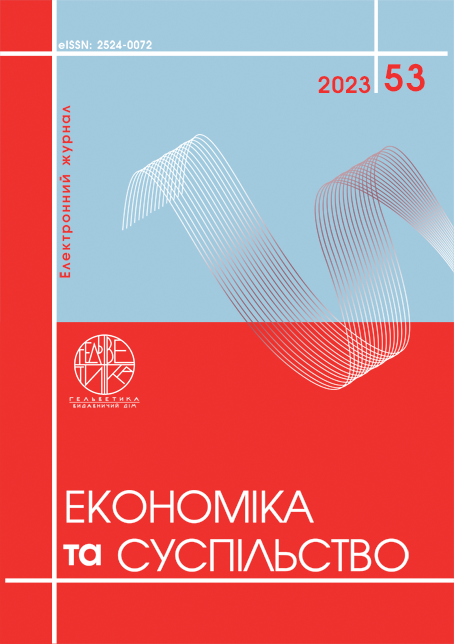MODERN APPROACHES TO THE VALUE ADDED MODELLING: STAKEHOLDER’S VISION
Abstract
In today's context, value is interpreted as tangible and intangible value that is the object of exchange between participants in modern business ecosystems. Market competition encourages continuous improvement of efficiency and the comparison of competing values. Analyzing the economic efficiency of an enterprise involves assessing the added value created for and in cooperation with stakeholders. Retrospective studies and analysis of significant scientific works and concepts of added value and value show that the Stakeholder Value Added (STVA) model does not correspond to the modern principles of interaction between market participants. The researchers of the stakeholder value added model have not considered the division of the company's beneficiaries into direct and indirect ones, i.e., those who receive financial and non-financial benefits, and thus there is no algorithm for estimating the value created separately for each group of stakeholders. The distinction of modern approaches to value added assessment for each of the stakeholder groups is due to the fact that it is difficult to ensure the sustainability of the transfer and acceptance of value in the sense of value by indirect stakeholders, which leads to the loss of part of this value, and thus complicates the process of its assessment and subsequent comparison with the values offered by competitors. The application of an interdisciplinary approach makes it possible to assess inconsistencies and develop modern approaches to modeling added value as a value for stakeholders, which will serve as a basis for improving the methodology of economic analysis and assessing the efficiency of the enterprise. This model will provide managers with the tools to identify the process of value creation, transfer and acceptance in the sense of value. These processes are difficult to reproduce and cannot be purchased, but they are the basis for the formation of sustainable competitive advantages that are designed to ensure the long-term development of the enterprise.
References
Шульгіна Л.М., Гуляйко В.М. Механізм формування споживчої цінності продукції поліграфічних підприємств : монографія. Київ : Univest PrePress, 2015. 223 с.
Давидов О.І. Моделі доданої вартості підприємств: економічний зміст та особливості побудови. Науковий вісник Міжнародного гуманітарного університету. 2017. № 28. С. 167–172.
Єрмак С.О., Лісніченко О.О. Максимізація вартості підприємств в умовах інноваційної економіки в контексті стейкхолдерського підходу. Ефективна економіка. 2015. № 1. С. 1–5.
Clarkson M. A Stakeholder Framework for Analyzing and Evaluating Corporate Social Performance. The Academy of Management Journal. 1995. Vol. 20, No 1. P. 92–117.
Spaniol M., Rowland N. Business ecosystems and the view from the future: The use of corporate foresight by stakeholders of the Ro-Ro shipping ecosystem in the Baltic Sea Region. Technological Forecasting & Social Change. 2022. Vol. 124. URL: https://www.sciencedirect.com/science/article/pii/S0040162522004875?via%3Dihub
Antràs P., Chor D. Global Value Chains. Working Paper 28549. 2021. URL: http://www.nber.org/papers/w28549
Figge F., Schaltegger S. What is «Stakeholder Value»? Developing Catchphrase into a Benchmarking Tool. University of Lineburg in Association of UNEP. PICTET. 2000. Vol. 54. URL: http://fox.leuphana.de/portal/files/1199097/Figge_Schaltegger_What_is_Stakeholder.pdf
Gereffi G., Fernandez-Stark K. Global Value Chain Analysis: A Primer, 2nd Edition. 2016. URL: https://gvcc.duke.edu/wp-content/uploads/Duke_CGGC_Global_Value_Chain_GVC_Analysis_Primer_2nd_Ed_2016.pdf
Jensen P. Value Concepts and Value Based Collaboration in Building Projects. Proceedings of CIB W096. Architectural Management, Technical University of Denmark. 2005. URL: https://www.irbnet.de/daten/iconda/CIB5528.pdf
Von Felten D., Van Der Voordt T., Coenen C. The Concept of Added Value of FM. 2012. URL: https://www.academia.edu/16301478/The_Concept_of_Added_Value_of_FM
The United Nations Sustainable Development Goals. URL: https://www.undp.org/sustainable-development-goals
Spaniol M., Rowland N. (2022) Business ecosystems and the view from the future: The use of corporate foresight by stakeholders of the Ro-Ro shipping ecosystem in the Baltic Sea Region. Technological Forecasting & Social Change. Vol. 124. Available at: https://www.sciencedirect.com/science/article/pii/S0040162522004875?via%3Dihub
Clarkson M. A Stakeholder Framework for Analyzing and Evaluating Corporate Social Performance. The Academy of Management Journal. 1995. Vol. 20, No 1. P. 92–117.
Davydov O. (2017) Modeli dodanoi vartosti pidpryiemstv: ekonomichnyi zmist ta osoblyvosti pobudovy [Models of the added value of enterprises: economic content and peculiarities of construction]. Naukovyi visnyk Mizhnarodnoho humanitarnoho universytetu, no 28, pp. 167–172.
Yermak S, Lisnichenko O. (2015) Maksymizatsiia vartosti pidpryiemstv v umovakh innovatsiinoi ekonomiky v konteksti steikkholderskoho pidkhodu [Maximizing the value of enterprises in the conditions of the innovative economy in the context of the stakeholder approach]. Efektyvna ekonomika, no 1, pp. 1–5.
Shulhina L., Huliaiko V. (2015) Mekhanizm formuvannia spozhyvchoi tsinnosti produktsii polihrafichnykh pidpryiemstv [The mechanism of formation of consumer value of products of printing enterprises]. monografiya [a monograph]. Kyiv: Univest PrePress, 223 p. (in Ukrainian)
Antràs P., Chor D. (2021) Global Value Chains. Working Paper 28549. 2021. Available at: http://www.nber.org/papers/w28549
Figge F., Schaltegger S. (2000) What is «Stakeholder Value»? Developing Catchphrase into a Benchmarking Tool. University of Lineburg in Association of UNEP. PICTET. Vol. 54. Available at: http://fox.leuphana.de/portal/files/1199097/Figge_Schaltegger_What_is_Stakeholder.pdf
Gereffi G., Fernandez-Stark K.(2016) Global Value Chain Analysis: A Primer, 2nd Edition. Vol.34. Available at: https://www.researchgate.net/publication/305719326_Global_Value_Chain_Analysis_A_Primer_2nd_Edition
Jensen P. (2005) Value Concepts and Value Based Collaboration in Building Projects. Proceedings of CIB W096. Architectural Management, Technical University of Denmark. Available at: https://www.irbnet.de/daten/iconda/CIB5528.pdf
Von Felten D., Van Der Voordt T., Coenen C. (2012) The Concept of Added Value of FM. Available at: https://www.academia.edu/16301478/The_Concept_of_Added_Value_of_FM
The United Nations Sustainable Development Goals. Available at: https://www.undp.org/sustainable-development-goals

This work is licensed under a Creative Commons Attribution 4.0 International License.


